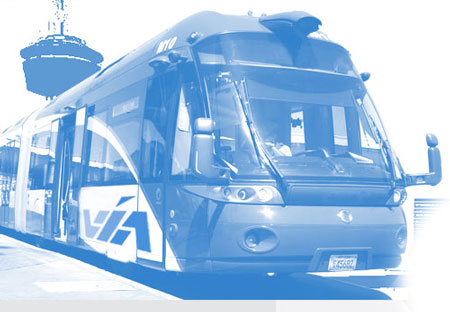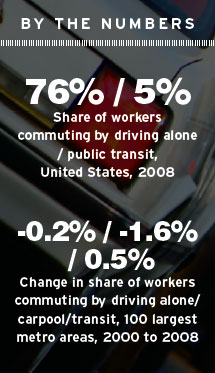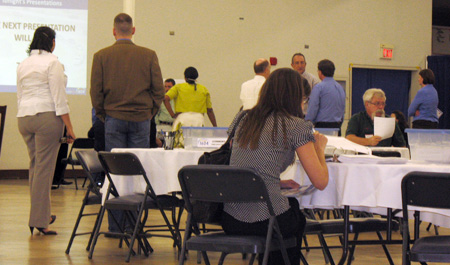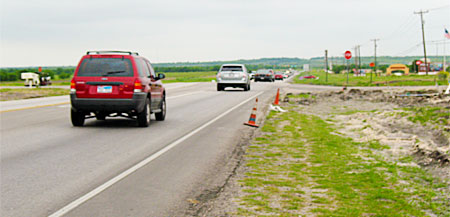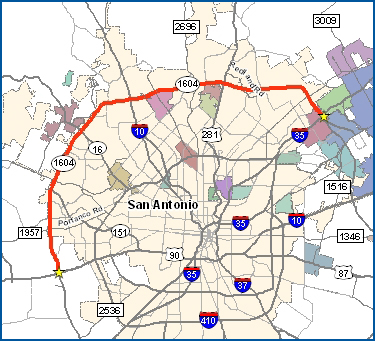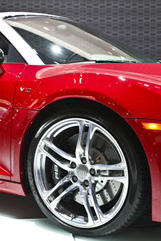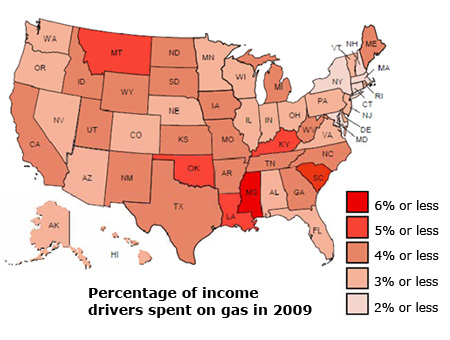Bicycling to downtown San Antonio on a summer day
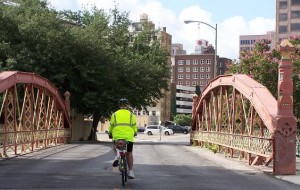
Augusta Street bridge, San Antonio
My wife and I spent some five hours out and about on our bikes yesterday, heading downtown from our house near Red McCombs Ford outside Loop 410 to the King William district. Altogether it came to a trip of 22.35 miles, mostly along San Antonio’s old main thoroughfares, San Pedro Avenue and Fredericksburg Road. We set of around 8:00 AM, when it was only 80 degrees and got back just before 1:00 PM, when it was well over 90. more »
See how San Antonio plans to make its buses perform like light rail
Can buses look and operate more like light rail?
VIA Metropolitan Transit officials think so. And now the public can peek under the hood of a plan to spend $57 million to speed up bus travel and make trips more comfortable along Fredericksburg Road.
The agency will hold three public meetings over two weeks to explain the latest on an environmental study:
Monday, May 24
6 p.m.
Jefferson High School cafeteria
723 Donaldson
Thursday, May 27
1:30 p.m.
Norris Conference Center
Wonderland of the Americas Mall
4522 Fredericksburg Road, Suite A100
Thursday, May 27
6 p.m.
Norris Conference Center
Wonderland of the Americas Mall
4522 Fredericksburg Road, Suite A100
The study says buses could scoot along 30 percent faster on nine miles between downtown and the Medical Center, two prime job centers anchoring one of VIA’s busiest routes. More than a fourth of the area’s 79,000 residents depend on transit.
The cost for bus rapid transit, as it’s called, includes traffic signal controls to give buses more green time, faster ticketing, sidewalk-level boarding, two roomy transit centers and eight enhanced stations. The hope is that developers will create walkable, mixed-used hubs around the stops.
The cost does not include dedicated bus lanes on part of the route, as proposed in previous plans that put the tab at around $100 million.
Construction is supposed to start this year, with service starting in late 2012.
LINKS:
Commuting Passenger rail Transit
by Patrick
Comments Off on One in four commuters are part of this growing national trend
One in four commuters are part of this growing national trend
One in four big-city commuters walk to work, ride bicycles, use transit or at least share car rides with other workers, a new study says. A good number even stay home to work.
In other words, 24 percent of Americans in the 100 largest metro areas don’t drive solo to work, according to “The State of Metropolitan America,” a report released this week by the Brookings Institution.
And though a whopping three-fourths still drive alone, that portion has been shrinking, says the report’s 12-page commuting chapter.
From 2000 to 2008:
TRANSIT RIDERSHIP: went up for the first time in 40 years, reaching 5 percent in 2008, though that’s still shy of 5.1 percent from 1990.
DRIVING SOLO: slid down slightly, mostly in 2007 to 2008, the first year of the Great Recession and a time of shockingly high gas prices. Austin led the nation’s biggest cities with a 3.6 percent drop.
CARPOOLING: dropped to 11 percent, less than the 12 percent from 1970.
TWO-WHEELING: by bicycle and motorcycle rose slightly, to 1.7 percent.
WALKING: declined to 2.8 percent, down from 7.4 percent in 1970.
TELECOMMUTING: jumped to 4.1 percent.
The report breaks down the trends by demographics and geography and mentions some other notable Texas numbers:
El Paso is third in the U.S. for a 3.2 percent increase in solo driving and second for a 5.2 percent decrease in carpooling; McAllen ranks in the top five for both the percentage of commuters who carpool and those who quit carpooling; and Houston is fifth for loss of transit share.
LINKS:
Every driver commits at least some of these six sins
Does talking to a passenger distract your driving?
Yes, it does, according to safety officials. And that’s just one of a half dozen habits that distract motorists.
Drivers are considered distracted when they:
- Talk to passengers
- Smoke
- Eat
- Fiddle with dashboard controls
- Reach for something
- Talk or text on a cell phone
OK, so some of these, especially the last one, aren’t surprises. And it’s the last one that Oprah Winfrey is targeting with her “No Phone Zone” Day, which is tomorrow.
Agencies across the nation, including the Texas Department of Transportation, have joined Oprah’s campaign. Tomorrow, electronic highway signs will flash, “Make Your Vehicle a No Phone Zone,” or “Drive Now. Text or Talk Later.”
Motorists using hand-held devices are four times more likely to be in a crash, TxDOT says. All distractions caused 103,526 accidents and 524 deaths in Texas in 2008.
Nationwide, distractions led to 5,870 deaths and 515,000 injuries, statistics show.
Young people are especially vulnerable. Almost half of teens use phones while driving, a Texas Transportation Institute study found.
More information:
Commuting Construction and closures Toll roads Transit: Loop 1604
by Patrick
1 comment
What’s in store for your Loop 1604 commute?
Here’s the gist of what’s being laid out, in a series of public meetings wrapping up tonight, for Loop 1604’s future.
The problem, officials say, is that traffic demand in 25 years will be twice as much as what can fit on the highway today. The lanes can currently handle about 80,000 vehicles a day, but demand is 110,000 now and will surge to 155,000 by 2035.
An environmental study is sizing up impacts of three basic strategies:
Buses and passenger rail. At best, this can meet 15 percent of demand when you consider that top-notch transit cities such as San Francisco, Washington and Boston snare about that much of the trips in those cities.
Managing and improving traffic flows. This is done with engineering, like the super street idea, and behavior incentives that range from carpooling to staggered work hours and telecommuting. California enacted laws requiring large employers to use such commuting strategies but cut traffic just 3 percent.
Adding four lanes to the highway. Since each lane can handle about 20,000 vehicles a day, that would do the trick.
So you can see where the math leads.
However, a dozen various community criteria will also drive decisions, and that produces a little more mix into the approaches.
Commuting Construction and closures: Loop 1604 stimulus funds
by Patrick
Comments Off on Loop 1604 getting a helping of stimulus
Loop 1604 getting a helping of stimulus
Workers began plopping orange cones into place along Loop 1604 near Randolph AFB and driving in heavy machinery last week.
The job is to widen the road into a four-lane divided highway from FM 78 to Graytown Road by summer 2011, according to the Texas Department of Transportation. Federal stimulus dollars are funding the $6.63 million cost.
“These improvements have been in the works for several years but were unfunded,” TxDOT engineer Frank Holzmann said in a statement. “With availability of economic stimulus funding, we now have an opportunity to move forward on this.”
But moving forward could be a slow and/or muddy affair for now. The National Weather Service has forecast rain throughout the week.
Massive Loop 1604 study goes back to the public
The top ideas on how to add lanes to almost half of Loop 1604 will be laid out in a series of three public meetings this week so officials can get input.
With gas taxes strangled by decades of inflation, diversions and political inaction, toll fees and toll-backed bonds have emerged as a primary path to get some things done on the 37-mile stretch of highway.
A previous study was derailed in 2008 after toll opponents and environmental activists filed a lawsuit in a federal court. The lawsuit in part called for Loop 1604 and U.S. 281 to be studied together, since they would have been part of an interrelated tollway system, and the judge seemed to agree.
For this week’s meetings, study officials will provide several short presentations each night, from 6 to 8:30 p.m.:
- Monday, Valero Headquarters, Building D, One Valero Way.
- Tuesday, Live Oak Civic Center, Main Hall, 8101 Pat Booker Rd.
- Wednesday, Vale Middle School, cafeteria, 2120 N. Ellison Dr.
For more information or help, start out at More for 1604’s event page.
Other links:
Automobiles Commuting Uncategorized
by Patrick
Comments Off on Top-rated cars for working people
Top-rated cars for working people
The New York International Auto Show has been offering up plenty of glam and muscle to hog the spotlight since last week.
MSN has had fun giving us the show’s 10 most notable unveils, and the 10 sexiest rides — i.e., to your right is a glimpse of the Audi R8 Spyder (go ahead, click the glitz for a full view).
“Give us sports cars and make them sexy as hell,” MSN’s Matthew de Paula declared. “We want 10-mile-per-gallon Lamborghini Gallardos and 510-horsepower Aston Martins all the way.”
Closer to ground level, Consumer Reports plodded forward to give us the New York standouts. Cars.com patiently poked and prodded the show’s winners and losers.
It’s a lot to digest, sort of like trying to eat your way into a bargain at an all-you-can eat buffet.
I guess that’s why my thoughts keep drifting back to a more meat-and-potatoes Top Picks announced just before the noise revved up in New York. Using affordability, comfort and safety as criteria, AAA selected the best cars to commute to work in.
And topping AAA’s list is the …
Texans pay a lot for gas
I admit, I don’t know exactly how much I pay for gas every year. I bet most people don’t. But we should, because it’s a lot.
Average Texas drivers paid $1,819 for gas last year, chewing up 4.9 percent of their incomes, according to numbers crunched by the National Resources Defense Council.
Texas ranked seventh among states for percent of incomes spent on gas. Mississippi was first with 6.2 percent, while Connecticut was last with just 2.5 percent.
Remember, though, regular-grade gas last year was 90 cents a gallon cheaper than in 2008, when prices careened to $4 a gallon. Thus, the point of this NRDC white paper: What would happen if prices, which are steadily rising, spiked again?
For Texans, the answer is gas bills 80 percent higher — or 8.7 percent of incomes. If the next spike turns into a steep plateau, the bill over a year would average $3,264.
Links:
Automobiles Bicycles Commuting Roads Toll roads Transit Travel
by Hugh
Comments Off on 2005 Dodge Caravan 4th anniversary
2005 Dodge Caravan 4th anniversary
This is somewhat obscure but while searching through papers for the upcoming tax adventure, I happened upon the original sales document for my 2005 Dodge Caravan which I purchased exactly four years ago to the day, March 28, 2006. Since then I have added 69,271 miles to its already high one year total of 28,702 – it was probably a rental that maxed out early – making a grand total, as of today, of 97,973. more »
